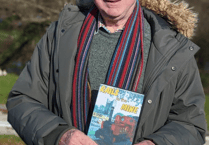The pub at St Dominic is at one end of the road that spans the village and the church is at the other. In between these two mainstays of village life through the centuries - and into 2000 and beyond - are a number of other elements which are vital to those who have chosen to live in the area.
The village hall, which opened in l974, is sited right on the road, as are the primary school, the Victory Hall which serves as a snooker club, and the village shop and post office, built at the turn of the century. All, in their various ways, ensure that St Dominic (or St Dominick, as it is spelt both ways) is a hive of activity. As does the natural productivity of the land. It is one of the Tamar Valley villages which long ago gained a reputation for the quality of fruit and vegetables grown there, and even today many families have connections with market gardening.
The village book, produced by the Cornwall Federation of WIs, explains that St Dominic's 'Who'd Have Thought It' Inn was originally the Butchers Arms. However, locals termed it the Sheffield or 'Sheffel' as when St Dominic fair took place in the open space in front of it salesmen used to come and sell Sheffield cutlery.
Today the inn is run by Drew Potter whose family have been at the Who'd Have Thought It for around 38 years. It is a welcome retreat for the local football and snooker teams, as well as among the establishments regularly visited by the Hash House Harriers.
Intriguingly the lounge bar is the Straw Bar, traditionally said by locals to be where those with more than a few pennies relax, while the public bar is the Hay bar. When the younger customers then started to gather in a bar at the back it was jokingly termed the Silage bar.
The pub is among the businesses who provide a cup at the local gymkhana, organised annually by Di Irons at Smeaton Farm, and traditionally very well attended.
Bombs
The bar was used as a courtroom on one occasion for a murder trial, and its furniture is far from the brash, neon lit tubing that constitutes many a pub in the 21st Century, but harks back to a less hectic age.
The village hall plays host to an array of vibrant local groups and associations, such as the garden club, the aikido club, the karate club, line dancing, the parents and toddlers' playgroup, the local Rif-Raf amateur dramatic society who produce the local pantomime, the playgroup and the Senior Circle etc.
The hall committee has plans for the much used facility to be extended and generally refurbished, and the stage made larger. There are hopes that a Lottery grant will be able to see all this come into being. A larger stage will certainly be of benefit to the members of Rif-Raf who rehearse there, and are this year to put on a number of one act plays - some of them children's plays - by writers such as Alan Ayckbourne.
One of the Senior Circle members is Vera Duke, who moved to the village in l944, aged 17, to escape the flying bombs. She remembers that St Dominic began to expand around l953 when the Edgcumbes sold the land, which went to the National Trust. At one time the village took in a butchers, a tailor, and a shop at Bohetherick, as well as the shop/post office and the pub, which still remain. Her uncle was a market gardener, and much fruit used to be sent from the Cornish valley to the markets in London.
Audrey Babb came from Devon to live in St Dominic after marrying in l939 - her husband also being in market gardening. In fact the Babbs have lived in St Dominic since l700. Her memory takes in the arrival of electricity in l952 and the need, before then, to light homes with oil lamps. She said that when she moved there from Ivybridge the first thing she missed was street lights, because it was 'so pitch black when night fell'.
The bottom mill at Cotehele House, now owned by the National Trust and among the buildings there open to the public, is where Georgina Norish lived with her first husband, Charlie Sambles. She has lived in the area since l932, and her husband used to work for the mill.
The annual flower show at St Dominic is a major event, and has been going since l950. It was started by the WI, which has a strong following in the village and has been very involved in local events for many decades. Di Axtell, who is one of those who work in the local shop, is currently president of the WI, a churchwarden, chairman of the garden club/flower show, a governor of the primary school and a member of the parish council.
She moved to the village in February l969 from Cargreen, and soon became embroiled in all its myriad of activities.
Rosemary Shepherd is also a WI member and was chosen to attend the triennial general meeting at Wembley for St Dominic. She originally lived in Surrey, moved to Bristol, and then took another move further westward. Another dedicated WI representative is Win Foweraker who has been in the WI as an organisation since l956.
She moved from Windsor in Berkshire, and assimilated into St Dominick life with remarkable ease, those WI ties helping along the way.
Freda Brown is married to George Brown, who dug the first turf to start the building of the village hall. The honour fell to him because his late father, Frank Brown, was chairman of the parish council which started the village hall fund with £50 - a sum which began many years of fundraising. The land for the building was given by Fred Hancock.
St Dominic school is an integral part of the village. Being a Church of England school it is involved very much in church events, and local senior citizens also meet the youngsters, and lunch there every Wednesday.
Headteacher Vicky Young highlighted the contribution of the Friends of St Dominic School organisation which also involves many grandparents, as well as willing parents.
Family
Mrs Young emphasised that it is a happy school whose governors are very involved in its events. A newsletter regularly goes out into the community, outlining to villagers exactly what events the pupils have been involved in, or are hoping to achieve in the future.
The village shop and post office nestles near to the church, which is said to derive its name from a young Irish nun, St Dominica.
The shop stands on a site where a pub, The Cornish Arms, used to be. The shop building was erected at the turn of the century, and the postmaster and mistress Mr and Mrs Rabbage were the great grandparents of Nesta Martin, who runs the business now.
Others in her family who have been involved in the shop have been a great aunt Mrs Frank Ford, while a naval man, Nelson Colwill, also took over the business reins for a while.
Nesta herself was born in the village, and her shop is one of the central points where people met each other.
Many have been signing the petition - which has been placed in rural post offices throughout the country - calling for the Government to support such village businesses, and abandon its policy of paying benefits straight to banks through a centralised system.
Homes
Also working at the shop is Mary Behennah, who has been a member of staff there for almost six years. She said: 'Everyone comes in here - it's a real focal point.'
Mary has been at St Dominic for 30 years. Her husband John, a builder, has been involved in the building of the village hall, and almost all the new homes in the area.
The WI explain that St Dominica arrived at Halton Quay around AD 689, and founded a settlement at the site now known as Chapel Farm, where a holy well still stands.
There were two Methodist chapels in the area, of which Ebenezer chapel still survives.
One of the oldest houses is Halton Barton where Sir Francis Drake is said to have fought a duel.



